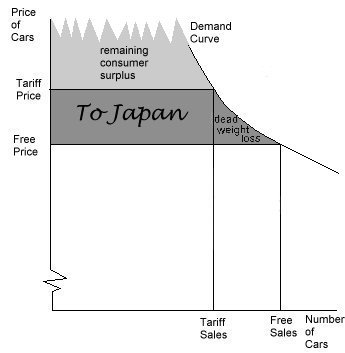 Deadweight loss caused by trade protection:
Deadweight loss caused by trade protection:Under free trade, Japan sells the "Free Sales" number of cars to the US for the "Free Price". The revenue will be : Free Sales times Free Price, measured by the two rectangles below in the graph right of this text.
Consumer surplus will be everything some consumers would have been willing to pay more but did not have to because the price was not as high as they were willing to pay. Consumer surplus is mearsured by the total surface under the demand curve and above the horizontal "Free Price" line (total of grey). Quota protection (fixing the maximum of Japanes cars to be imported to some amount, called here "Tariff Sales") raises the price of Japanese cars in the US to "Tariff Price". Now, total revenue equals Tariff Sales times Tariff Price, measured by the two rectangles left (white plus gray) in the graph right of this text. Whether total revenue will be smaller or greater than under free trade is not obvious. What is sure is that consumers loose part of their surplus: the dark gray area. The left part is now payed to Japan, and the right side is dead weight loss: socially lost opportunity. It is a social cost of the behaviour of car industries opting for government quota protection instead of free competition.